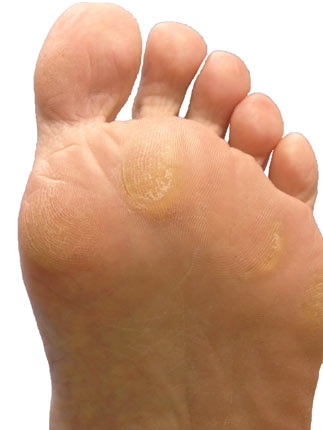Connect With Us
Calluses
 A callus, also known as hyperkeratosis, is an area of hard, thickened skin that can occur across the ball of the foot, on the heel, or on the outer side of the big toe. Although many consider them a skin problem, they are indicative of a problem with the underlying bones or our biomechanics (the way we walk).
A callus, also known as hyperkeratosis, is an area of hard, thickened skin that can occur across the ball of the foot, on the heel, or on the outer side of the big toe. Although many consider them a skin problem, they are indicative of a problem with the underlying bones or our biomechanics (the way we walk).
Calluses form from repeated friction and pressure, as the shoe (or ground) rubs against a bony prominence (bone spur) on the toe or foot. The skin thickens in response to this pressure. Small amounts of friction or pressure over long periods of time cause a corn or callus. A great deal of friction or pressure over shorter periods of time can cause blisters or open sores. Calluses typically develop under a metatarsal head (the long bone that forms the ball of the foot). Calluses have painful nerves and bursal sacs (fluid-filled balloons that act as shock absorbers) beneath them, causing symptoms ranging from sharp, shooting pain to dull, aching soreness.
A plantar callus forms on the bottom of the heel over time where one metatarsal bone is longer or lower than the others. This structure causes the one metatarsal to hit the ground first and with more force than it is equipped to handle. As a result, the skin under this bone thickens. In most cases, plantar calluses can be treated without surgery. In some recurring cases, however, a surgical procedure, called an osteotomy, is performed to relieve the pressure on the bone.
A condition called Intractable Plantar Keratosis (IPK) is a deep callus directly under the ball of the foot. IPK is caused by a "dropped metatarsal," which happens when the metatarsal head drops to a lower level than the surrounding metatarsals and protrudes from the bottom of the foot. This results in more pressure being applied in this area and causes a thick callus to form. A dropped metatarsal can either be a congenital abnormality, a result of a metatarsal fracture, or a structural change that may have occurred over time.
If you suffer from calluses, it is important to have X-rays taken and have your feet evaluated by a Foot and Ankle Specialist.
Conservative (Non-Surgical) Treatment:
- Custom orthotics may be needed to offload the pressure areas
- Periodic debridement by a foot and ankle surgeon to relieve pain from calluses may be required
- Prescription creams may be used to keep calluses manageable
Surgical Treatment:
- Surgical procedures may required to repair the underlying biomechanical problems causing the calluses
Contact a Foot and Ankle Surgeon today at Academy Foot and Ankle Specialists for a thorough exam and treatment plan.
